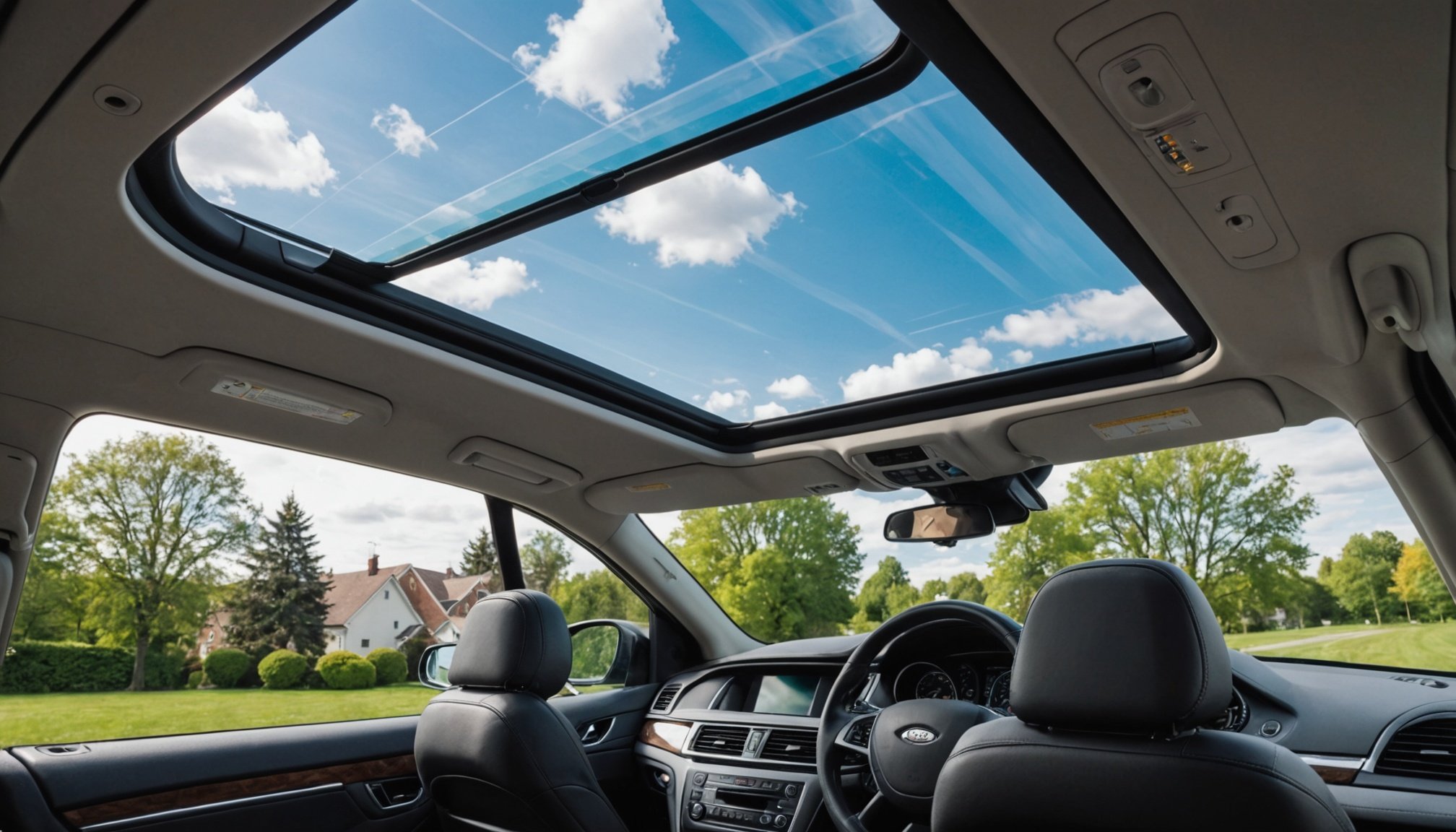Understanding Panoramic Sunroofs
A panoramic sunroof is a large, expansive glass feature installed on the roof of a car, offering an enhanced view of the sky. These sunroofs typically extend further than standard models, providing both front and rear passengers with a greater aesthetic experience. There are primarily two types: fixed panoramic roofs, which remain closed at all times, and automatic variants, which can open to allow airflow into the vehicle.
The benefits of adding a panoramic sunroof to British sedans encompass both aesthetic and functional advantages. Aesthetically, these sunroofs contribute to a sleek and contemporary design, often increasing the vehicle’s resale value by enhancing its appeal. Functionally, a sunroof can improve cabin lighting, making the interior feel more spacious and welcoming. It also offers passengers the option to enjoy fresh air without excessive wind noise associated with open windows.
Also to read : Transforming Your British Classic Car: A Step-by-Step Guide to Upgrading with a Modern Infotainment System
However, some common misconceptions persist regarding panoramic sunroofs. A frequent belief is that they significantly decrease fuel efficiency due to increased weight. While there is a marginal effect, advancements in vehicle technology have largely mitigated this issue. Others may worry about leakage, but with proper maintenance, this is generally not a concern.
Tools and Materials Needed
When installing a panoramic sunroof, you’ll need specific tools and materials to ensure a successful installation. Essential equipment includes both common and specialized gear. Firstly, a sunroof kit is a must. This typically contains the panoramic glass, frame components, and often some standard fasteners. Alongside this, you’ll need a set of high-quality adhesives suitable for automotive use, which are crucial for sealing and security.
Also read : Step-by-Step Guide: Installing a Wireless Charging Pad in Your British Electric Vehicle
For tools, installation tools like screwdrivers, pliers, and wrenches are obvious necessities. But also consider investing in precision tools such as a torque wrench for accurate fastening and a power drill with various bits for preparing holes. Glass handling equipment will make dealing with heavy and potentially dangerous materials much easier.
When it comes to sourcing, prioritize quality over cost. Look for reputable brands that specialize in automotive tools and materials. This ensures reliability and longevity, reducing the risk of errors or future issues. Online marketplaces and automotive specialty stores often carry these items. Verify reviews and seek recommendations to guide your purchasing decisions, ensuring you have everything needed for your panoramic sunroof installation to maximize safety and effectiveness.
Step-by-Step Installation Guide
Installing a sunroof on your British sedan can be a rewarding DIY installation project. However, following a precise guide is crucial for success.
Pre-Installation Preparation
Before embarking on the installation, ensure thorough preparation of your vehicle. Begin by taking accurate measurements, which are essential for a precise fit. Conduct detailed assessments to verify that the sunroof is suitable for your model. Reviewing the manufacturer’s instructions carefully is vital, as this ensures completeness and addresses unique vehicle specifications. Compatibility checks cannot be overlooked—they help identify potential issues early, ensuring a smoother installation process.
Cutting the Roof
One of the most critical steps involves cutting the roof. Utilize the included templates for marking the cut area, adhering to the guidelines meticulously. Consider these tips:
- Use a sharp, precise cutting implement.
- Double-check your measurements.
- Protect the vehicle’s interior from debris.
This precaution prevents errors and offshore calls for expertise or replacements.
Installing the Sunroof
Securing the sunroof involves detailed installation steps. Follow these:
- Align the sunroof properly.
- Ensure all fasteners are tightly secured.
- Apply water-resistant sealant generously around the edges.
Achieving a water-tight seal is pivotal for preventing leaks and enhancing the system’s longevity. The result is not only functional but also visually pleasing and durable.
Finalizing Installation
Final installation steps include essential cleaning and detailed visual checks. Clean all surfaces and seals to ensure a neat finish. Verify that all components fit correctly, aligned and functioning smoothly. This meticulous attention to detail ensures the installation is both secure and aesthetically gratifying.
Safety Precautions During Installation
When installing robotic appliances, prioritising safety precautions is crucial. Ensuring you have the right safety gear is essential to prevent accidents. Equip yourselves with gloves and protective eyewear to shield against potential injuries from sharp tools or debris. Additionally, wear sturdy footwear to protect your feet from heavy objects.
Recognising common hazards can help you avoid unnecessary risks. Watch for slippery surfaces and ensure your workspace is well-lit to prevent tripping or falling. Be cautious of electrical components; make sure all devices are powered off before handling. Never underestimate the dangers of using sharp tools or working with glass and metal parts.
Sometimes, having an extra pair of hands can be invaluable. A helper can assist in holding parts or tools, especially during complex segments where precision is paramount. This teamwork reduces the likelihood of mishaps occurring during handling or assembly. For heavier installations, an additional person can provide the necessary physical support, reducing strain and risk of injury.
As you navigate the installation tips, remember that preparation and mindfulness are your best allies. Planning your tasks and understanding potential challenges can enhance safety and result in a smoother installation experience.
Potential Challenges and Solutions
In the installation process, some common challenges might arise that could impede progress. One frequent issue is misalignment, which can disrupt the entire setup. To address this, ensure that all components are properly aligned before continuing with the installation. Check for any imbalances or misfits, and make adjustments as needed.
Troubleshooting these challenges often involves paying attention to details that might seem minor but can lead to significant misalignment. Start by examining the main elements to ensure they are correctly positioned. Typically, consulting the installation manual offers great insights into avoiding or correcting these issues.
For more complex installation challenges, you may need to think about seeking professional help. If initial troubleshooting fails to resolve the problem or you’re uncertain about performing adjustments, a professional’s expertise can prevent further complications.
While it is empowering to tackle these problems independently, knowing when to call in experts ensures the installation is done efficiently and saves time. Professional assistance can be a reliable solution, particularly when facing unresolvable challenges or lacking the technical skills required.
Cost Estimates and Budgeting
When considering the installation costs of a renovation project, it’s crucial to outline all potential expenses. The primary costs typically include tools, materials, and possibly professional labor. Tools can range anywhere from basic hand tools to specialized equipment, depending on the project’s complexity. Materials often make up a significant portion of the budget, including anything from lumber and tiles to fixtures and fittings. Professional labor costs vary greatly based on the scope of the work and local rates.
Effective budgeting can mitigate unforeseen expenses. Allocate funds for hidden costs such as permits, inspections, or even potential delays. An excellent method is to set aside a contingency fund, generally around 10-20% of the total estimated budget, to cover unexpected surprises.
Another aspect to consider is how these initial expenses can be offset by an increase in resale value. Investing wisely in materials and workmanship may substantially increase your property’s resale value, essentially reimbursing you for some of the initial outlay. It’s crucial to evaluate the local real estate market to understand potential gains. Balancing upfront costs with future benefits can ensure a smoother financial process for your renovation project.
Maintenance and Care for Your Panoramic Sunroof
To ensure the longevity of your panoramic sunroof, consistent care and routine maintenance are essential. Start with regular checks to detect any potential issues before they escalate. Look for common issues such as leaks or unusual noises, which could indicate loose seals or obstructions in the sunroof tracks. These problems, if left unchecked, could lead to more significant damage.
For cleaning, choose products that are specifically designed for automotive glass and frames. Applying harsh chemicals can lead to discolouration or damage. A mild glass cleaner, paired with a soft microfiber cloth, will keep the glass clear without scratching. Pay particular attention to the corners and edges where dirt and debris often accumulate.
Additionally, clear any debris from the sunroof tracks to prevent jamming. Gentle use of a vacuum or compressed air can help dislodge trapped dirt. Regular lubrication of the moving parts with a silicone-based lubricant can enhance smooth operation and prevent wear.
In conclusion, routine sunroof maintenance and adopting a proactive approach to addressing common issues will ensure your panoramic sunroof remains in optimal condition. By following these care tips, you safeguard not only its functionality but also its aesthetic appeal over time.











